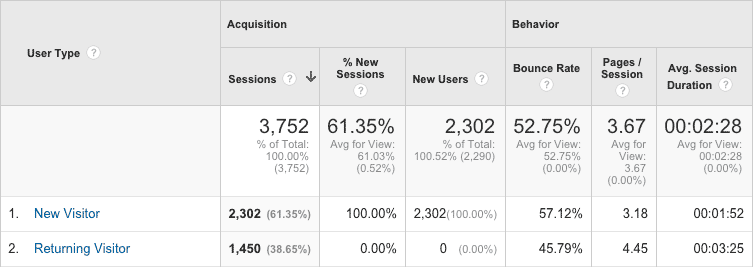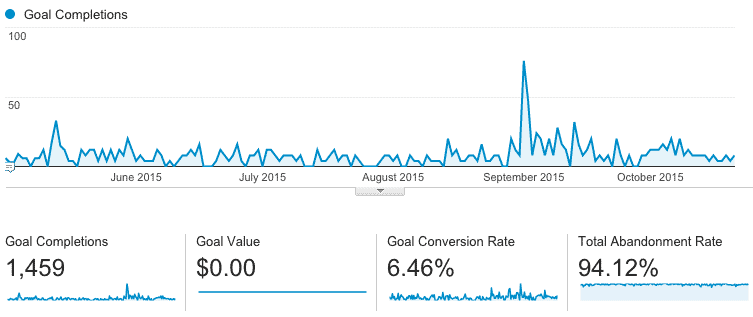An Analysis of Google Analytics
by on Oct 21, 2015
by on Oct 21, 2015
Google Analytics is far and away the number one analytics tool in use on the web today. In 2014, it was reported that 67% of Fortune 500 companies use Google Analytics, with somewhere in the range of 29.5 million total websites using the data platform. So just what is Google Analytics, why has it seen such a high rate of adoption, and what can it do for you? In this article, we’ll cover all these questions and more, to show you in what ways Google Analytics can help you get more out of both your website and your overall marketing efforts.
Google Analytics is a free but comprehensive web-based program that tracks a wide array of data about almost every visitor to your website. You may be familiar with “counter” programs of old, which tracked each individual “hit” to your website. We felt pride and joy every time we visited our website only to see our counter had gone up by two, five or ten hits since last time we checked!

These counters were the early pre-cursors to the more feature-rich analytics programs of today. To implement a counter you copy and pasted a few lines of code into your own website’s code that ticked up one every time someone reloaded your page (including every time your Aunt May in Ohio refreshed the page to see anything new you added). These gave you a better understanding of how popular each page of your website was, but lacked more specific capabilities, such as seeing how many people were first-time visitors, or what region of the world your visitors were located.
To get started with Google Analytics, you begin by creating a Google account (or logging in to an account you already manage) and going through a series of setup steps that help Google identify what website you want to track. Google. Google does some behind-the-scenes verification to make sure you are the owner of that website, preventing you from tracking information for a website that you are not affiliated with. Once your account is set up, Google provides you with a snippet of code (similar to the one in the image below) to be copy and pasted into the code of your own website.

This snippet should be added in a specific place within the overall structure of your website’s code. For this reason, we suggest that you consult with a developer (like us!) to ensure that your Analytics code is incorporated in the correct place. Within 24 hours, Analytics will begin collecting data about almost all of your website visitors.
Almost all? Although Google Analytics can paint a much more detailed picture of your website traffic than you’ve been able to see before, there are several reasons (some fixable, some not) that may prevent you from receiving some or all of your data.
At this point in the article you may be worried that your Analytics data will be so different from your actual traffic that it may not be worth reviewing at all. That’s far from the case! Although each of the above scenarios are common occurances, they are not absolute roadblocks that prevent you from making informed decisions based on the data you are seeing. They are simply important pieces of information to keep in mind as you are analyzing your own data.
Now that you have Google Analytics up and running, what types of data will you start to see?
Acquisition - how viewers found your website, where they are coming from (such as a search engine, an affiliate website, an email campaign, one of your social media pages, etc.), what keywords they used to find your website, if they came to your website by typing in your url directly, etc.

Demographics - age, gender, interests, device (such as mobile or desktop, and even more specifically, which mobile device model), browser and version, internet provider, geography, language, and more.

Behavior - what day and time they visit, what pages they view and for how long, what page they are viewing when they close your website, if they have been to your website before, etc.

Conversions - if set up, you can see the exact behavior flow of people who complete a “conversion” of your choosing, such as making an online purchase, filling out a contact form, or downloading a white paper.

Although it’s helpful to see each individual piece of the above information, the real power of Analytics comes from evaluating all of this information together, especially by considering them in the context of your business goals or marketing objectives.
One of the first questions we get after someone views their Analytics for the first time is, “is this number good or bad?” It’s important to remember that each piece of data you collect is neither good nor bad in and of itself. Knowing you receive five daily visitors or 500 doesn’t mean much until you consider it in the context of who this traffic is, what they viewed, and what the outcome of their website visit was. Five daily visitors who convert to sending you an email is a far better statistic than 500 viewers who bounce off the homepage right after loading it.
Here’s a more detailed example. You are given access to a website’s Analytics, and see that 5% of all website traffic is between the ages of 45 and 55. Would you consider that to be good or bad? It depends, of course! Without taking into consideration what the website is about, or who their target demographic is, you can’t make the determination if 5% means their website is performing the way it should be.
Let’s say the website is for a travel agency, who specializes in bucket-list, around-the-world adventures. You’d expect to see more traffic from people in the age range of 45 to 55, meaning this travel agency may not be reaching the right demographics with their marketing efforts (since such a small percentage of all of their website traffic is in that age range). Alternatively, you may find out that this travel agency has been running a big marketing campaign to promote the idea that bucket-list travel is for people of all ages. In that case, the seeing “only” 5% for that age range means that many other age ranges may be represented, and may signal a success in terms of their marketing efforts for that particular campaign. This is why it is so important to define your business and marketing goals before you try to ascertain how your website traffic is performing against those goals.
Similarly, reviewing your website traffic may give you a more accurate representation of what your demographics look like, versus what you think they look like. They can show you what your website viewers want to read or interact with, as opposed to what you think they want to read or interact with. Analytics can provide you with the information needed to bridge the gap between what you think about your customers versus who they really are. Without truly understanding who your customers are, none of your marketing efforts will be as successful as they could be.
Lastly, your Analytics may give you insights into potential avenues of additional revenue that you may not have recognized before. Our travel agency may note that 15% of their website traffic is made up of female seniors, ages 65+, who are cooking enthusiasts. This may spur the travel agency into putting together a food-related travel adventure that takes into consideration limited mobility. Without having the Analytics to identify this niche group, this travel agency may never have recognized that this type of opportunity within their potential customers existed.
Although the number of examples of what you can infer from your Analytics are endless, the takeaway should be that Analytics provides you the opportunity to make better business and marketing decisions - ones that are based specifically on activities surrounding your business that you may otherwise never be able to quantify.
If you need help setting up Google Analytics, have more questions about how it works and what it can do for you, or would like assistance in analyzing data you’ve already collected, we welcome you to reach out.
Photo courtesy of flickr user Roel Willems.